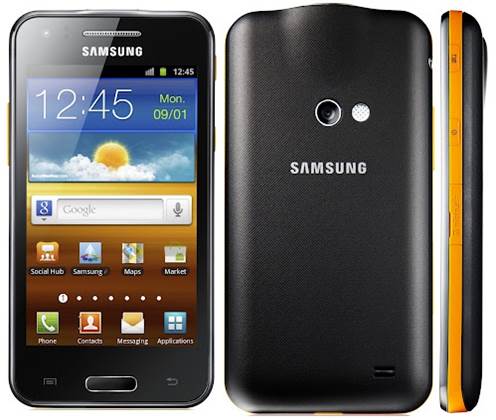With a stream, which seems to be endless,
of luxury phones pouring in the market at the edge of the holiday season, it
can be possible that some devices serving narrower customer ranges be /neglected.
Of course, Samsung Galaxy Beam unfortunately drops into this case, because it
consists of the built-in Pico Texas Instrument DLP projector. All told, the
phone encounters a huge challenge: while the projector might be useful for the
Power Point crowd, the phone itself belongs to the under average segment, and
it is not powerful enough to satisfy businesspeople. With the dual-core 1GHz
NovaThor CPU, the outdated operating system, the 2010-era screen and the normal
5 MP camera, the targeted customers of this product will be very small. However,
whether the projector is able to help the device maximize its ability? Will
such a device find a place in the crowded market? Read this review for further
detail. Feel and think our thought of this Samsung Galaxy Beam.

Samsung
Galaxy Beam
Hardware
In many aspects, this product is not much
different from a redesigned Galaxy S Advanced to fit the projector settings.
While both look so distinguishable, the technology specifications are very
similar, except for the battery capacity. For instance, those two devices both
have the dual-core 1GHz NovaThor CPU with 768MB RAM, WVGA TFT4 inch screen and
a 5MP back camera with the ability of recording 720p videos. Both have the 8GB
internal storage, although Advanced also has the option of 16GB. They are not
the only differences between both of them, but now, you might know the problem.
The outside is another story. The Galaxy
Beam owns a sporty and highly durable outlook, with the black textured battery
cover and a big yellow band covers the outside of the device. (Note: the
white-gray option is also available in particular markets) Despite the standard
MIL-spec device, we doubt its durability, at least it is successful in make
good impression that its cover is not made of normally cheap materials. Of
course, it feels robust and the 124x64.2x12.5 mm frame (4.88x2.53x0.49 inches)
is small enough to be hold tightly. With the weight of 5.11 ounce (145g), the
phone is not very heavy, but the projector still makes it heavier than other average
4 inch products.

The
white-gray option is also available
The hotspot is on the top edge of the
phone, and a bulge poking out the top of the battery cover is created by its
weight. Let’s applause the designers with this idea: we think it is not easy to
design a phone around a projector (or vice versa), and designing group did an
excellent job when combining them in a frame without turning them into a mess. Yes,
this phone is much thicker than what we have been gotten used to, but it is
still very comfortable to hold. In reality, this might be the reason why
Samsung chooses to be faithful to the 4 inch design – of course, we can
recognize that this level of thickness becomes a big problem for devices with
larger screen. Because the top of the Beam seems to be a proper place for the
3.5 mm earphone jack, this special feature is moved to the left side of the
phone to make room for the projector. This is not a good place for it – most of
smartphone users who regularly listen to music find this design discouraging
when they need their devices to be in their pockets. Ultimately, in this case,
the best place for the jack is at the bottom.
Accompanying the earphone jack on the left
side is the volume rocker and large-size SIM slot. This is the reason for a
huge disappointment because almost all smartphone are introduced in the second
half of this year take all advantages of the micro-SIM slots. If the SIM is
smaller, you will need to exchange it for a larger one or quickly find a $1
adapter. However, be cautious: the SIM port’s ejection mechanism might be
unusual (the memory cards are easily plugged in, but taking them out requires
more effort), so stay away from cheap plastic adapters.
On the right side of the phone stands an
on/off switch of the projector, the standard power button and microSD slot. The
latter port can supports memory cards whose capacities are up to 32GB, which is
very essential because you just have 8GB for the built-in memory (which finally
results in less than 6GB that you can use). A micro-USB charging port lies at
the bottom of the phone. Like what we have mentioned before, the Beam’s screen
is TFT WVGA 4 inch (800x480). This is the resolution type that you mainly find
on low-cost phones now. Honestly, we would like a HD screen here, especially
due to the $430 price. Samsung’s decision to use TFT instead of PenTile Super
AMOLED is such a rational decision, because we are hardly distracted by
pixilation or jagged edges. Although it is not the definition quality screen
like what we prefer on pretty phones nowadays, we still find it is interesting
to watch movies. Besides, the screen is bright enough for us to read under
daylight, and the viewing angle is also better what we expected before.

The
Beam’s left side with earphone jack and SIM card slot
The back cover has a soft rubbery surface
with smooth texture providing more space to hold and keep the fingerprints
away. You will also see the 5MP camera and LED flash in the front and middle,
with the Samsung logo lying right below. The only different feature on the back
is the speaker grille, which is slightly raised to prevent the speaker from
being muffled. Accompanied beneath are the back case and 2000mAh battery which
are easily to remove.